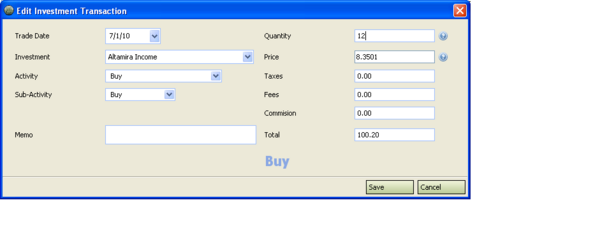Work with an individual investment
From MTHWiki
| Line 122: | Line 122: | ||
*Payee: Payee is predicated with a @ symbol, for example @Apple, Inc. All Investment Payees are grouped into Payee Type - '''Investments''' | *Payee: Payee is predicated with a @ symbol, for example @Apple, Inc. All Investment Payees are grouped into Payee Type - '''Investments''' | ||
| - | *Category: Category is Investments | + | *Category: Category is '''Investments''' |
| - | *Sub-Category: Sub-Category is the transactions Investment Activity, for example Investments: Buy | + | *Sub-Category: Sub-Category is the transactions Investment Activity, for example '''Investments: Buy''' |
Revision as of 19:27, 1 July 2010
Contents |
Overview
Transactions such as buys, sells, splits, and options can be manually entered for an investment or, if your brokerage firm supports online banking, you can download this information directly into MyMoney.
Setting up an investment
- Select a Position on which you will be recording a transaction
- In the Position Register select New
- In the New Investment screen, select Activity, such as Buy or Sell.
- Type the Quatity/Price, the Transaction Total will be calculated automatically based on this information
- Provide Taxes and Fees information if you have it
- Press Ok to save this transaction
When you enter the quantity, price, commission, and total of a transaction, MyMoney can help you check the calculations to check for errors. Fill in three of the fields and press the Tab key while in the third field to calculate the figure for the fourth field. Once calculated the fourth field should match your investment’s paper statement.
The investment will appear under the Portfolio in which it is held. You can add transactions to the investment to keep the investment holdings current and record special activities like a transfer, stock split, spin-off or company merger.
How MyMoney displays Amounts
Internally MyMoney keeps track of numeric data in a double-precision 64-bit IEEE 754 floating point numbers. However, for display purposes the numbers are approximated as follows:
- Quantity/Units: MyMoney displays the number of shares to four decimal places; for example, 12.0031
displays as 12.0031. It displays exact integers with four trailing zeros, for example 12 will be displayed as 12.0000
- Price: MyMoney displays the price to four decimal places; for example, 12.0031
displays as 12.0031. It displays exact integers with two trailing zeros, for example 12 will be displayed as 12.00
- Total: MyMoney displays the total to two decimal places; for example, 12.0031
displays as 12.00. It displays exact integers with two trailing zeros, for example 12 will be displayed as 12.00
- Taxes, Fees and Commission are displayed similar to Total field.
What to enter into Quantity field
In the Quantity/Units field, enter the number of Security Units (such as shares) you acquired (or owned) on the date you entered in the Date field.
Use this table to help you decide what to enter for different types of investments:
| Security type | Number of shares to enter |
| Stock or mutual fund | The actual number of shares |
| Money market / CD | The total dollar value |
| Bond / Domestic Bond | Face value of the bond |
| Currency | The number 1 |
Face value of the bond: Face value of the bond also called the par value, is the value of the bond when it matures. Most bonds have a $1,000 face value. The face value is used to calculate interest payments. For example, a 5 percent bond with a face value of $1,000 pays $50 interest annually
What to enter into Price field
MyMoney will automatically populate the Price field with the last known pricing quote for a given security. You can adjust it manually so it matches the price you paid.
In the Price field, enter the enter the initial price you paid per share as a decimal.
Use this table to help you decide what to enter for different types of investments:
| Security type | Price to enter |
| Stock or mutual fund | The actual price per share |
| Money market / CD | The number 1 |
| Bond / Domestic Bond | The price of a bond as stated as a percentage of the bond's face value. |
| Currency | The total dollar value |
Cash Balances
There are 4 types of Investment Transactions that affect cash balances, these are:
- Purchases, such as Buy, Buy Stock, Buy Mutual Fund etc
- Redemptions, such as Sell, Sell Stock, Sell Mutual Fund, etc
- Distributed Distribution, such as Investmnet Income, Return of Capital, Margin Interest
- Investment Expense
When an Investment transaction is created or modified and it is deemed to affect cash balances then a corresponding cash transaction is created automatically on the Investment Accounts register to maintain cash balances.
Investment transaction and cash transaction pair are coupled together and cash transaction is not modifiable directly. To change it or delete it you need to change or delete the coupled Investment transaction.
MyMoney creates a Payee and Category for the cash portion of the Investment transaction automatically, these are the rules used in this process:
- Payee: Payee is predicated with a @ symbol, for example @Apple, Inc. All Investment Payees are grouped into Payee Type - Investments
- Category: Category is Investments
- Sub-Category: Sub-Category is the transactions Investment Activity, for example Investments: Buy



